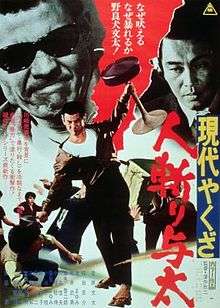Street Mobster
| Street Mobster | |
|---|---|
 Japanese release poster | |
| Directed by | Kinji Fukasaku |
| Written by |
Yoshihiro Ishimatsu Kinji Fukasaku |
| Starring |
Bunta Sugawara Noboru Ando |
| Music by | Toshiaki Tsushima |
| Cinematography | Hanjiro Nakazawa |
| Distributed by | Toei |
Release dates |
|
Running time | 92 minutes |
| Country | Japan |
| Language | Japanese |
Street Mobster, known in Japan as Gendai Yakuza: Hitokiri Yota (現代やくざ 人斬り与太), is a 1972 Japanese yakuza film directed by Kinji Fukasaku and starring Bunta Sugawara and Noboru Ando. It is the sixth installment in Toei's Gendai Yakuza series of unrelated films by different directors, all starring Sugawara. Shot on location in Kawasaki, the plot centers around Okita, a street thug troublemaker released from prison only to discover that the crime underworld in which he used to operate and the socio-political landscape of Japan has changed dramatically. Complex named it number 3 on their list of The 25 Best Yakuza Movies.[1] Home Vision Entertainment released the movie on DVD in North America in 2004.[2]
Summary
Okita and his street gang cause trouble in Kawasaki, residing in an abandoned warehouse, they extort money and sell girls to brothels. When they are beat up for refusing to give the Takigawa yakuza family a cut, Okita attacks them with a knife and is sent to jail. After being released he teams up with yakuza Kizaki and subsequently immerses himself in the new yakuza scene, forming his own gang, and runs into one of the girls he raped and sold into prostitution, Kimiyo, whom he starts a volatile relationship with.
After crossing the Takigawa family several more times, Okita is injured and forced into joining under Takigawa's rival, the Yato family, to protect himself and having a truce ceremony with Takigawa. This gives him control of a piece of the entertainment district, giving him an easy life that bores him. Not happy with the truce, Takigawa has talks about uniting with the large Saiei family from Osaka. When Okita disrespects Saiei boss Owada and refuses to apologize even after Yato commits yubitsume, he is expelled from the Yato family.
After nearly his whole gang is killed off one by one, Okita and his two remaining men hold up in the abandoned warehouse. Yato has Takigawa killed and gives the turf to Saiei as a peace offering, promising to get Okita to apologize if they will spare Okita's life. Yato talks Okita into surrendering, with Okita even cutting off a finger. To Yato's surprise, the Saiei family begin beating Okita as a lesson, while keeping the promise not to kill him. However, when Kimiyo arrives and tries to stop it, she is killed sending Okita into a frenzy that results in his death and Yato being stabbed.
Cast
- Bunta Sugawara as Isamu Okita
- Noboru Ando as Shunsuke Yato
- Asao Koike as Kizaki
- Hideo Murota as Miyahara
- Kyosuke Machida as Takeo Gunji
- Mayumi Nagisa as Kimiyo
- Noburo Mitani as Taniguchi
- Asao Uchida as Eisaku Owada
- Takeo Chii as Yasuo
- Mayumi Fujisato as Katsuko
- Sayoko Tanimoto as Okita's mother
- Nenji Kobayashi as Tetsuo
- Toshiyuki Tsuchiyama as Kazama
- Keijiro Morozumi as Takigawa
- Mariko Jun as Yukari
- Chie Kobayashi as Kaoru
- Koji Fujiyama as Ronanushi
- Nobuo Yano as Karasawa
- Hiroshi Date as Kawabe
Production
When he was chosen to direct the sixth installment in the Gendai Yakuza ("Modern Yakuza") series, Fukasaku decided to depict a low-ranking street thug. Scriptwriter Yoshihiro Ishimatsu brought in a first draft, however the director thought it too similar to his Sympathy for the Underdog and took to rewriting it. Residing in a cheap hotel in Shinjuku, Fukasaku could not work as he was so engrossed in watching the Asama-Sansō incident on television. He later told film critic Sadao Yamane that he tried to incorporate the "thrilling essence" of the incident into Street Mobster.[3]
The film's lead, Bunta Sugawara who had yakuza friends, said he gave Fukasaku many suggestions while filming. Such as how someone who has never shot a gun would do so.[4]
References
- ↑ "The 25 Best Yakuza Movies". Complex. Retrieved 2014-10-02.
- ↑ "Street Mobster". Amazon.com. Retrieved 2014-10-02.
- ↑ Macias, Patrick, Street Mobster DVD booklet, 2004, Home Vision Entertainment. Retrieved 2014-08-23
- ↑ Schilling, Mark (2003). The Yakuza Movie Book : A Guide to Japanese Gangster Films. Stone Bridge Press. pp. 130–143. ISBN 1-880656-76-0.